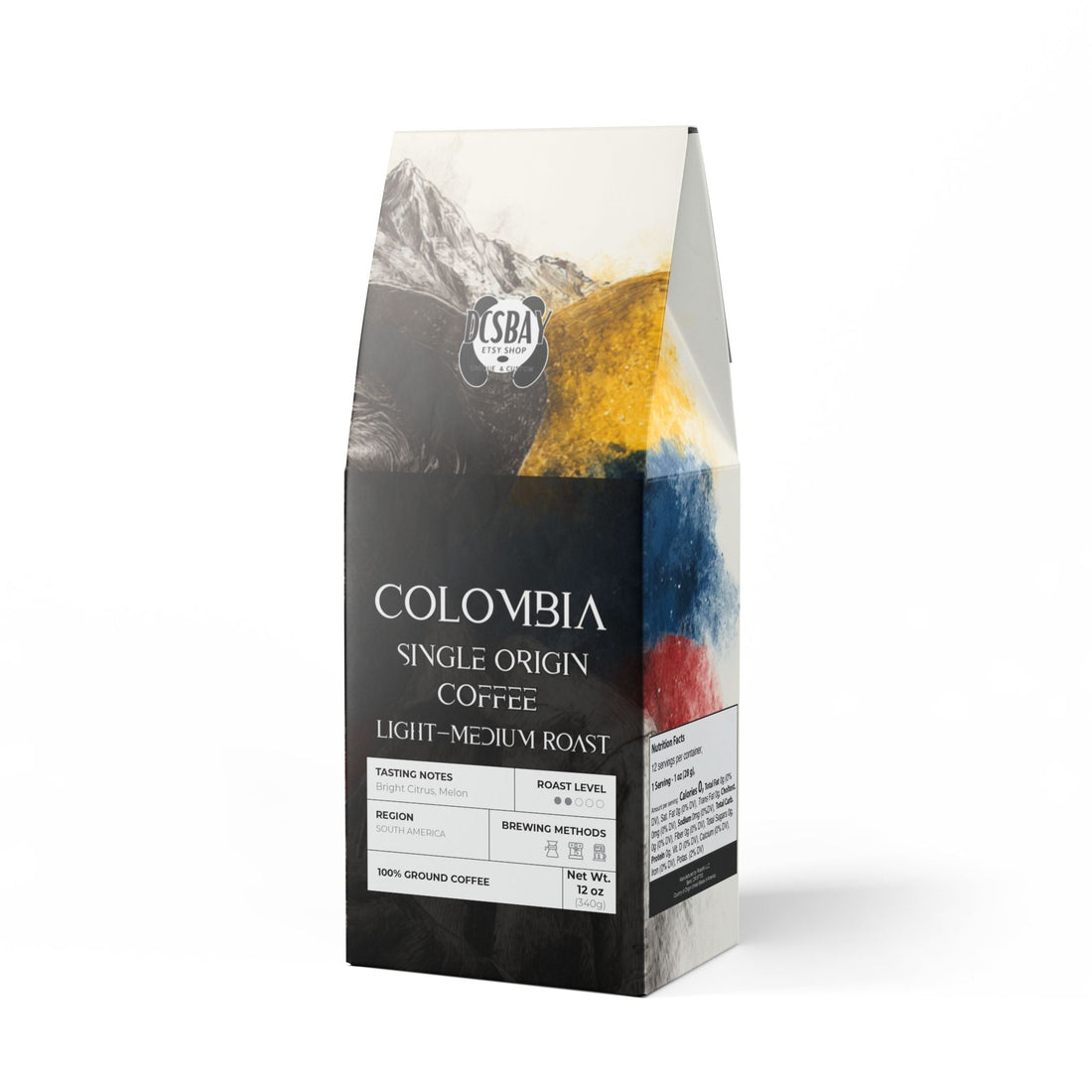
Colombian Coffee: The Legacy of a Single Origin Treasure
Share
When you think of coffee, a few iconic names come to mind—and Colombian coffee is undoubtedly one of them. Known for its rich flavor, smooth body, and vibrant aroma, Colombian coffee holds a prestigious place in the global coffee industry. But there’s more to this reputation than meets the eye. In recent years, there's been a growing appreciation for single origin coffee, a term that has become a buzzword among coffee enthusiasts. Understanding what single origin means—and how it differs from coffee blends—can elevate your coffee experience from ordinary to extraordinary.
In this article, we’ll explore the story of Colombian coffee, what makes single origin coffee unique, and how it compares to blends. Whether you’re a casual drinker or an aspiring connoisseur, this deep dive will enrich your morning brew with knowledge.
The Rich Heritage of Colombian Coffee
Colombia is the third-largest coffee producer in the world, following Brazil and Vietnam. However, in terms of premium Arabica coffee, Colombia is a standout producer. The country’s geography and climate play a massive role in this distinction.
Climate and Geography
Colombia's location near the equator, its high-altitude mountains, volcanic soils, and steady rainfall create ideal growing conditions for Arabica coffee beans. The three major coffee-producing regions—the Coffee Triangle (Caldas, Quindío, and Risaralda), Nariño, and Huila—offer unique microclimates that impact the flavor profile of the beans.
For example:
-
Huila coffee is known for its bright acidity and fruity notes.
-
Nariño coffee tends to have a balanced body with citrus undertones.
-
The Coffee Triangle produces well-rounded beans with nutty and chocolatey characteristics.
This regional diversity gives Colombian coffee a broad flavor spectrum, making it ideal for both single origin offerings and blends.
What Is Single Origin Coffee?
Single origin coffee refers to coffee that is sourced from one specific place. This could be a country, a region within a country, a single farm, or even a specific lot within a farm. The key is traceability—knowing exactly where your coffee came from.
This contrasts with blends, which combine beans from multiple locations to create a consistent flavor profile.
Types of Single Origin:
-
Country-specific (e.g., Colombia, Ethiopia)
-
Region-specific (e.g., Huila, Colombia)
-
Farm-specific (e.g., Finca El Paraiso in Cauca)
-
Microlot or Nanolot (e.g., a small portion of a farm's harvest, sometimes from a specific altitude or variety)
The value of single origin coffee lies in its purity and uniqueness. Just like wine varies by vineyard and vintage, single origin coffee offers a taste of place, often called “terroir”.
What Makes Colombian Single Origin Coffee Special?
Colombian coffee is well-suited for single origin status for several reasons:
1. Exceptional Quality Control
The Federación Nacional de Cafeteros (FNC), Colombia’s National Coffee Federation, maintains high standards for cultivation and harvesting. The FNC supports over 500,000 coffee farmers with education, infrastructure, and fair trade policies, ensuring that Colombian coffee maintains its global reputation.
2. Flavor Profile
Colombian single origin coffees often boast:
-
Medium to full body
-
Bright acidity
-
Notes of caramel, nuts, red fruits, and citrus
-
Clean, balanced aftertaste
Each region adds its own twist, which makes Colombian single origin coffees distinct yet approachable.
3. Sustainability and Ethics
Many single origin farms in Colombia are Rainforest Alliance Certified or part of Fair Trade cooperatives. Consumers can feel confident that their coffee purchase supports environmental sustainability and fair wages.
Blends vs. Single Origin: What’s the Difference?
Let’s break down the differences between coffee blends and single origin coffee, highlighting the pros and cons of each.
| Feature | Single Origin Coffee | Coffee Blends |
|---|---|---|
| Source | One location or farm | Multiple locations |
| Flavor Profile | Unique, traceable, terroir-specific | Balanced, consistent |
| Complexity | Can be nuanced or bold, depending on origin | Harmonized flavor from various beans |
| Consistency | May vary by harvest | Designed for consistent taste |
| Price | Usually higher | Often more affordable |
| Roasting Styles | Often light to medium to showcase origin | Varies—usually medium to dark |
| Ideal For | Pour-overs, tastings, specialty cafés | Espresso, milk-based drinks, daily brews |
Why Choose a Blend?
Blends are not inferior—they serve a different purpose. Roasters combine beans to achieve:
-
A stable flavor all year
-
A balanced profile (body, acidity, sweetness)
-
Better suitability for espresso and milk-based drinks
Many well-known commercial brands and café chains rely on blends to deliver a consistent experience to customers.
Why Choose Single Origin?
Single origin coffee is ideal for:
-
Exploring new flavors
-
Brewing methods that highlight detail (e.g., V60, Chemex, AeroPress)
-
Ethical and environmental transparency
-
Understanding a region's terroir
For coffee lovers who see drinking coffee as a culinary experience, single origin is the way to go.
Brewing Colombian Single Origin Coffee
To truly appreciate single origin Colombian coffee, choose manual brewing methods that allow its flavor to shine:
Recommended Methods:
-
Pour Over (e.g., Hario V60) – Highlights clarity and acidity.
-
Chemex – Offers a clean, bright cup.
-
French Press – Brings out body and richness.
-
Aeropress – Allows control over brewing variables for experimental tastes.
Grind and Water:
-
Use filtered water just off the boil (around 92–96°C / 197–205°F).
-
Match your grind size to the brewing method.
-
Weigh your coffee-to-water ratio (e.g., 1:16 for pour overs).
Brewing Colombian single origin coffee right gives you a cup with layered flavors, clean finish, and satisfying depth.
A Glimpse Into the Future: The Rise of Micro-Lots
With the growing demand for transparency and traceability, micro-lot Colombian coffees are gaining attention. These are tiny harvests with unique traits—perhaps from a specific varietal, altitude, or post-harvest process (like honey or natural processing).
Buying micro-lots supports experimental farming practices and rewards innovation. These coffees are often sold through specialty auctions or direct trade platforms, making them prized possessions for roasters and consumers alike.
Conclusion: Every Cup Tells a Story
Colombian coffee isn’t just a beverage—it’s a reflection of land, labor, and legacy. Its high-altitude regions, dedicated farmers, and favorable climate make it ideal for both single origin connoisseurs and blend drinkers alike. Whether you enjoy the complex, bright notes of a Huila single origin or the smooth harmony of a Colombian blend, one thing is certain: coffee is more than just caffeine—it’s culture in a cup.
As you sip your next brew, take a moment to consider the journey of those beans—from the Andean mountains of Colombia to your mug. Whether it’s a single origin or a blend, the story behind each cup is worth savoring.
